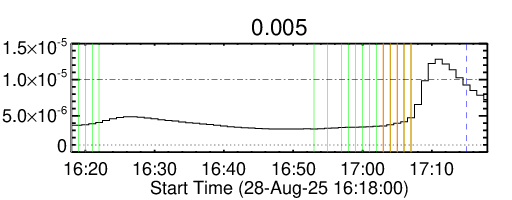
This refers to the "hot onset precursor event", the "HOPE" characterization of the precursor to a solar flare or CME. This seems to be a universal property, and the humble GOES soft X-ray data allow us to detect flare occurrence early, often well in advance of the main phase of a major event. The hot onset phenomenon, as yet not understood theoretically but highly reliable, underpins to the flare anticipation scheme ("FAI") used here in an empirical manner.
This implementation marks the alert occurrence with vertical dotted lines, according to criteria set on emission-measure growth rates for plasma at flare temperatures above 6 MK. Very crudely, green anticipates a C-class event, gold an M-class event, and red an X-class event. These vertical lines will not appear until two minutes plus NOAA latency have elapsed; at present the wait for NOAA to provide real-time data is about 4 minutes. Note that NOAA only provide one-minute averages this way. C, M, and X levels appear as dotted, dashed, and solid horizontal lines. The example below shows an M-class flare anticipation from 29-Aug-2025, more or less a random example.

The title "0.005" is the incremental emission measure in units of 1049cm-3 for the green verticals, roughly indicating a C-class flare to follow; M and X anticipations are marked with orange and red verticals. In this example the earliest flare premonition was about 18 minutes prior to GOES peak, with M recognized 8 minutes prior.
Note that the flux may go to zero for a few minutes, or even an hour sometimes. This is probably the result of an Earth occultation (eclipse period) which happens seasonally.